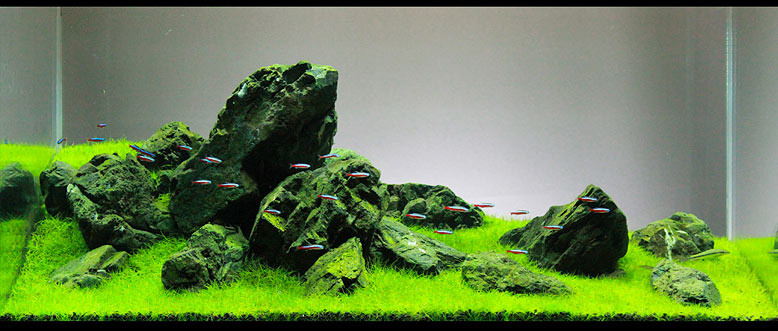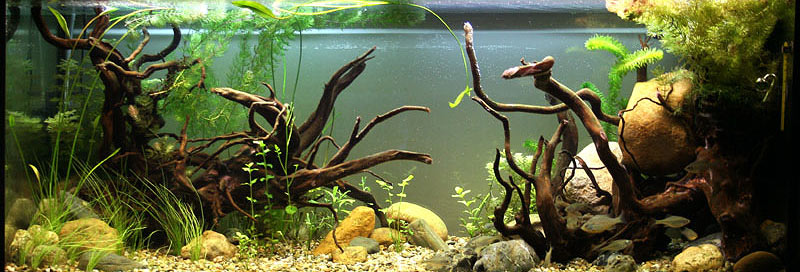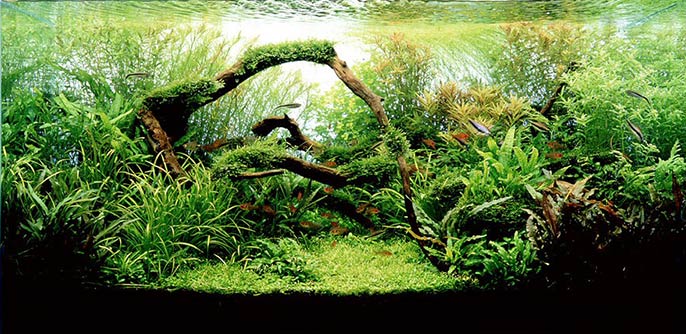7 Best Aquascaping style for Aquariums
Date: 2018-07-26
When you’re creating an aquarium, the possibilities are limitless. Everything from bare-bottom tanks to densely planted Dutch tanks are perfectly valid styles.
However, you’ll probably create a much more appealing result if you’re following a particular aquascaping style. CIPS News team collects many articles and here recommend a useful knowledge to share with our audience. It is from the editor of “theaquariumguide“. In the article, the editor introduces the 7 most common styles you’ll see in aquariums.
Dutch Style
This style is characterized by many different types of plants with multiple leaf types. It’s commonly seen with raised ‘layers’, or terraces, known as Dutch ‘streets’.
The floor is covered by either a carpet, or plants, with taller plants lining the back of the tank. Most noticeably, it usually has no hardscape—you won’t see much, if any, stone or driftwood in Dutch tanks.

Taiwanese Style
This isn’t very common anymore, and has in some areas fallen ‘out-of-style’ compared to the Iwagumi or Nature Aquarium tank.
Nonetheless, it’s usually seen with high terraces of varying depth, and its strangest feature is small objects or figurines placed in the tank to create a sense of ‘life’.
Taiwanese Style Planted Tank

Iwagumi Style
This is one of the most popular aquascaping styles today. It was first made popular by the Father of Modern Aquascaping, Takashi Amano, and is characterized by a series of stones arranged according to the Golden Ratio, or Rule of Thirds.
There should always be an odd number of stones to prevent the layout from ‘balancing’, since the human eye always tries to see a ‘split’ in balanced layouts.
There are at least three stones: a larger ‘Father’ stone, and at least two secondary stones. There can be more, so long as the total number remains odd.
These tanks may imitate a natural landscape, with a common theme of simplicity and open space. There are limited colors in plants & stone, and the number of varying flora and fauna is kept to a minimum to create minimalism.
Scale is very important in this style. Powder-type substrate is used to create a sense of larger scale, and the father stone should be the largest object in the aquarium. Nano fish like the Neon Tetra are also used to maintain the scale.
Iwagumi Style Planted Tank

Biotope Style
This style seeks to perfectly emulate a natural environment, including water conditions, flora and fauna species, and even the hardscape of stone and/or driftwood. These can be quite beautiful, and are useful for some biologists to study environments that would otherwise be a challenge to study.
Oddly enough, these tanks are usually somewhat easier to setup and maintain, since there isn’t any research needed to determine whether the flora and fauna you’re using are compatible—they exist side-by-side in the wild.
Biotope Style Planted tankJungle Style
This style is somewhat self-explanatory. The goal is to emulate a jungle, whether that’s the Amazon, or some other location. They’re quite popular in larger tanks, where the full scale of the style can be effectively portrayed.

Jungle Style Planted Tank

The Nature Aquarium
This style is the one you’ve probably seen all over the Internet, in various forums, and winning tons of awards.
And for good reason—they’re breathtaking tanks. These tanks seek to recreate various terrestrial landscapes—hills, mountains, valleys, and so on.
These are further categorized into various substyles, like the ‘island’ type, which features a stone ‘mountain’, or mound in the middle, or the triangular type, where the substrate and genearl flow the tank slopes down from one corner of the tank.
Nature Style Aquarium

The Walstad Method
You’re not likely to find this style winning any Aquascaping awards, though it is a very visually appealing layout.
That’s because the goal isn’t necessarily winning beauty awards, but recreating a completely natural situation.
Where this differs from nature aquariums and biotopes is its completely random placement of hardscape and plants. This is to simulate the way things are naturally in nature, instead of placing for optimal beauty.
These tanks are most often deliberately low-maintenance, and are by design low budget tanks. They usually use potting soil and also require very few water changes, because of the plant density.

Finding Your Own Style
Of course, there are more aquascaping styles, and even more variances between each of these. it’s up to you to decide what type of tank you enjoy.
If you enjoy it, you’ll maintain it better and get more quality out of it, so choose what you’d like, and get started on your tank! And welcome to join CIPS International Aquascaping Contest.
About CIAC:
CIAC, Abb. For CIPS International Aquascaping Contest, is supported by CIPS (China International Pet Show) and CFAA (China Fisheries Aquascaping Association). Its aim is to bring people together in their passion for the freshwater aquarium and the aquascaping hobby. It is our goal to make the freshwater aquarium hobby grow by inspiring people worldwide and creating a bigger awareness for nature. Aquascaping contests motivate contestants to be creative and inventive. They help inspire other hobbyists in developing and enjoying the aquascaping hobby.
During CIPS 2017 leading aquascapers from 11 nations/regions worldwide were invited to Shanghai for the CIPS Live International Aquascaping Contest (CLIAC), also known as the Champion of Champions Contest. In 2018 the top 100 contestants of the CIAC medium to large aquarium category will have the opportunity to show their skills during CLIAC at CIPS 2018 in Guangzhou.
[Previous] How to be the beginner on Aquarium Plant Care
[Next] Top 6 signals on dog illness
Copyright © 2008-2025 | China Great Wall International Exhibition Co., Ltd.
 China International Pet Show
China International Pet Show